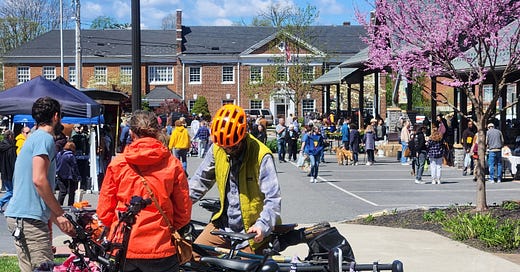Harrisonburg is in the final 16 for the Strongest Town Contest
Voting is live. Cities and towns will be eliminated over the next five weeks.
Consider this part three of my internal debate about whether Harrisonburg could compete in the Strong Towns competition (part 1, part 2). A little more than a week ago KC Kettler (of Livable Harrisonburg) and I filled out the application form, and last week we received word that Harrisonburg had made it to the “sweet sixteen” finalists in the Strongest Town Contest, a bracket-style voting tournament.
You can vote for Harrisonburg here. Voting for this round closes Thursday.
While I stand by the statements I made in my initial critique — we have a long way to go, and there are several “low hanging fruit” policies that should be implemented ASAP — it’s also true that there are many local organizations, developers, and city departments doing the work to make the Friendly City a strong town. Here are just a few examples:
The city recently announced a new process to sell surplus city-owned land to help spur residential development for housing
The redevelopment of the “Bird District” is a great example of adaptive re-use and mixed-use development in a place with no off-street parking minimums
HDR organizes the Best.Weekend.Ever festival every summer. Several streets downtown are temporarily closed to car traffic, and families, artists, and vendors fill the streets instead of cars. Traffic-restricted festivals like this can help us re-imagine what and who our streets are for
Our Community Place’s efforts to address homelessness with the Reservoir Street efficiency apartments across from Woodbine Cemetery
The Shenandoah Valley Bicycle Coalition organizes the annual Bike-Walk Summit, which brings together local leaders, cyclists, city staff, and pedestrian safety advocates to work on improving safety on our streets
The Community Connectors project in the Northeast Neighborhood is acknowledging the harms of Project R4 in the 1950s, and working to rebuild trust and a vision for the future of the neighborhood
This is by no means a comprehensive list. I’m sure you can think of other initiatives people are taking to incrementally improve our city, raise our quality of life, and make our city more economically resilient.
If you can think of other work that should be highlighted here, post a comment below and vote for Harrisonburg.






In addition to the many points above, Harrisonburg City used 10% of itsARPA federal funding related to Covid, that is $2 million, to support new construction of affordable housing in Harrisonburg. Half went to Habitat for Humanity to incentivize the construction of 11 homes. Half went to the Housing Authority to incentivize the construction of 16 apartments with vouchers for homeless persons. this is making a huge dent in the problem of access to housing for middle and lower income people. Sam Nickels
In terms of positive steps toward making Harrisonburg (or any place) a stronger town:
o Surplus city land should be LEASED and not sold. This allows for development but allows any future increase in land value (created by the community) to come back to the community through higher lease payments.
o The city could implement a Tax Shift whereby the property tax rate applied to privately created building values would be reduced while the rate applied to publicly created land values would be increased. The lower rate on buildings would make them cheaper to construct, improve and maintain over their useful lives. The higher rate applied to land values would help keep land prices lower. Thus, without new spending or revenue loss, this Tax Shift could make both buildings and land more affordable. As a bonus, this approach encourages infill development and reduces urban sprawl.